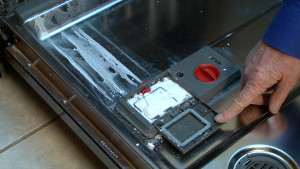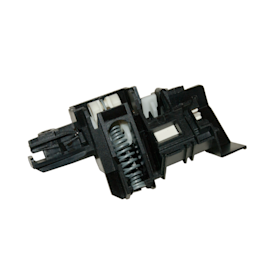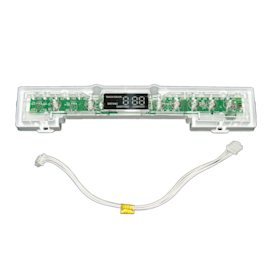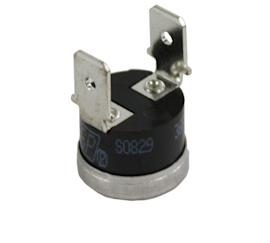Dishwasher detergent cup not opening video


If you notice soap left in your dishwasher’s detergent dispenser cup, you may be loading your dishwasher incorrectly. But if the cover on your dispenser doesn’t open at all, several things could be causing the problem. You may be overloading the dispenser, or using old clumpy soap. Or, your dispenser actuator might be broken. This video shows you how to access and test your dispenser actuator to determine if it needs to be replaced.
For additional dishwasher troubleshooting advice, step-by-step repair guides and error code charts, check out our Dishwasher DIY Repair page.
Tools and parts needed
Screwdriver
Multimeter
Work gloves
Hi, Wayne here from Sears PartsDirect. Today we're going to talk about what to do when your dishwasher dispenser won't dispense detergent. Many dishwashers use a detergent dispenser with a cover that flips up during the cycle, like this one. When the dishwasher door is shut, the cover presses against the top dishrack so the lid doesn't open fully, allowing spray from the lower spray arm to flush detergent out of the cup. When you open the dishwasher door, the cup cover flips open—you can hear it pop.
Don’t block detergent cup or spray arm
If there’s still detergent in the cup when you open the door, a dish might be blocking the dispenser during the wash cycle, preventing the soap from dispensing. Avoid blocking the dispenser when you load the dishwasher.
Another reason soap might still be in the dispenser is the spray arm couldn’t get enough water into the dispenser to push all the soap into the tub—usually because something is blocking the spray path between the lower spray arm and the dispenser. When loading the dishwasher, leave the path clear so plenty of spray reaches the dispenser cup.
Use fresh dishwasher detergent
Stale powder detergent can also get stuck inside the dispenser cup, because the caked powder won't dissolve as easily in the water. Replace your powder dishwasher detergent if the powder clumps together easily.
Don’t store powder detergent in the damp cabinet under the sink, where it absorbs moisture. Instead, store powder detergent in a cool, dry area such as an upper cabinet. If the cover is still closed when you open the door after the cycle, check the cup, cover and latch for soap residue that could prevent it from releasing the cover.
Residue can clog the cover latch and coat the inside edges of the cover or the outer rim of the dispenser cup, causing the cover to stick shut. Clean the cup, cover and latch and see if the cup cover opens properly. In the future, try not to overfill the dispenser cup.
Check for broken actuator
If the latch works and you aren't overfilling the cup, then the dispenser actuator may be broken. A wiring failure or a defective electronic control board could also prevent the cover from opening.
To find the cause, let’s check the wiring and measure the resistance of the dispenser actuator. Unplug your dishwasher or shut off the house circuit breaker for the dishwasher to disconnect electrical power. Open the dishwasher door and remove the Torx screws from the outer edges of the inner door panel. Support the outer door panel with one hand as you remove the final screws so the outer door panel doesn't fall. Separate the outer door panel and control panel slightly from the inner door panel, and rest the outer panel on the floor while you disconnect the user interface control wire harness. Pull off the outer door panel and control panel.
Check the wire harness connection on the dispenser and reconnect the wire harness if it's loose, or repair it if you find damage. If the wire harness looks okay, check the resistance through the dispenser actuator using a multimeter. Checking resistance of the actuator tells us whether current can flow through it. Pull off the female wire harness plug to expose the actuator prongs.
With your multimeter set to measure resistance in the 20,000-ohm range, touch one meter probe to each dispenser prong. You should measure between 1,400 and 2,800 ohms of resistance through the actuator. If you measure infinite resistance—on this meter that's a 1 in the far left corner—replace the dispenser assembly because the actuator isn't allowing current to flow.
Still not working? It's time to call a technician
If you measure the proper resistance through the dispenser actuator, then a wiring failure between the electronic control board and the dispenser or a defective electronic control board could be preventing the dispenser cover from opening. An internal mechanical failure in the dispenser could also be the cause.
Have a service technician examine and repair the dishwasher in this case; the technician can perform live voltage checks to see if the electronic control board is sending voltage to the dispenser actuator. Those checks should only be performed by someone with proper training.
I hope this video helped you out. You can find links to the parts we talked about in the video description. Check out our other repair videos here on the Sears PartsDirect YouTube channel. Subscribe and we’ll let you know when we post new ones.
Most common symptoms to help you fix your dishwashers
Choose a symptom to see related dishwasher repairs.
Main causes: broken door spring, damaged or broken door hinge…
Main causes: damaged or stuck spray arm, leaking door seal, damaged door hinge, leaky heating element water seal, cracke…
Main causes: broken door latch, tripped circuit breaker, broken heating element, faulty vent fan, sensor failure, contro…
Main causes: improper loading, low water temperature, improper detergent dosage, detergent dispenser failure, spray arm …
Main causes: clogged kitchen sink drain, clogged drain hose, drain check valve damaged, drain pump failure, control syst…
Main cause: damaged rack height adjuster…
Main causes: glass or popcorn kernel stuck in the chopper blade, drain line vibrating against the cabinet, debris in was…
Main causes: not using rinse aid, rinse aid dispenser failure, broken heating element, malfunctioning vent, drying fan f…
Main causes: light switch beside the sink turned off, lack of power, bad dishwasher door switch, control system failure,…
Most common repair guides to help fix your dishwashers
These step-by-step repair guides will help you safely fix what’s broken on your dishwasher.

How to replace a dishwasher door latch assembly
If the dishwasher door doesn't click shut, a broken door latch is a likely cause. Follow these instructions to replace i…

How to replace a dishwasher user interface control
The user interface control houses the selection buttons and display. If it fails, you can't select the cycle and setting…

How to replace a dishwasher thermal fuse
A completely dead control panel often indicates that the thermal fuse on the electronic control board is blown; follow t…
Effective articles & videos to help repair your dishwashers
Use the advice and tips in these articles and videos to get the most out of your dishwasher.

Get tips on completing essential holiday cleaning tasks to brighten your home.…

Learn about all the convenient features on our Sears PartsDirect website that make your parts purchases easier.…

Get answers to frequently asked questions about Sears and Sears PartsDirect.…
